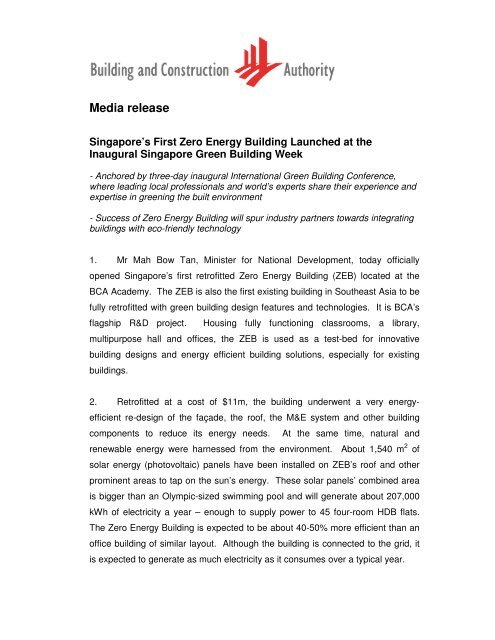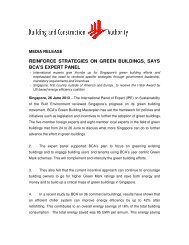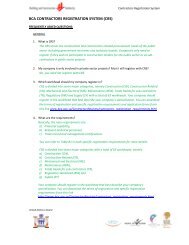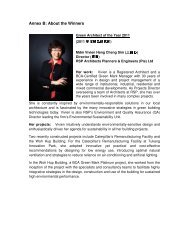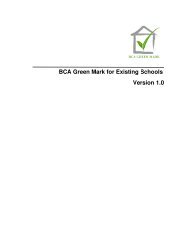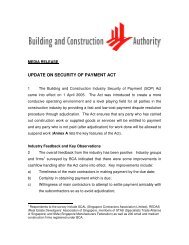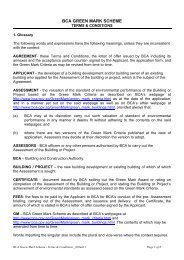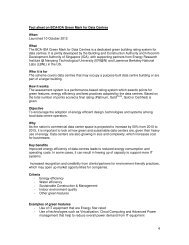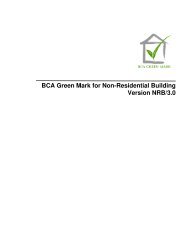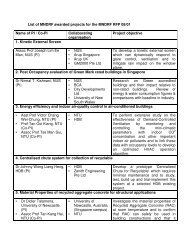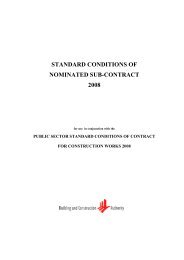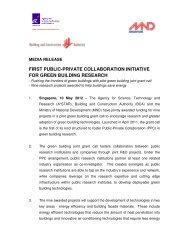Media release - Building & Construction Authority
Media release - Building & Construction Authority
Media release - Building & Construction Authority
You also want an ePaper? Increase the reach of your titles
YUMPU automatically turns print PDFs into web optimized ePapers that Google loves.
<strong>Media</strong> <strong>release</strong><br />
Singapore’s First Zero Energy <strong>Building</strong> Launched at the<br />
Inaugural Singapore Green <strong>Building</strong> Week<br />
- Anchored by three-day inaugural International Green <strong>Building</strong> Conference,<br />
where leading local professionals and world’s experts share their experience and<br />
expertise in greening the built environment<br />
- Success of Zero Energy <strong>Building</strong> will spur industry partners towards integrating<br />
buildings with eco-friendly technology<br />
1. Mr Mah Bow Tan, Minister for National Development, today officially<br />
opened Singapore’s first retrofitted Zero Energy <strong>Building</strong> (ZEB) located at the<br />
BCA Academy. The ZEB is also the first existing building in Southeast Asia to be<br />
fully retrofitted with green building design features and technologies. It is BCA’s<br />
flagship R&D project. Housing fully functioning classrooms, a library,<br />
multipurpose hall and offices, the ZEB is used as a test-bed for innovative<br />
building designs and energy efficient building solutions, especially for existing<br />
buildings.<br />
2. Retrofitted at a cost of $11m, the building underwent a very energyefficient<br />
re-design of the façade, the roof, the M&E system and other building<br />
components to reduce its energy needs. At the same time, natural and<br />
renewable energy were harnessed from the environment. About 1,540 m 2 of<br />
solar energy (photovoltaic) panels have been installed on ZEB’s roof and other<br />
prominent areas to tap on the sun’s energy. These solar panels’ combined area<br />
is bigger than an Olympic-sized swimming pool and will generate about 207,000<br />
kWh of electricity a year – enough to supply power to 45 four-room HDB flats.<br />
The Zero Energy <strong>Building</strong> is expected to be about 40-50% more efficient than an<br />
office building of similar layout. Although the building is connected to the grid, it<br />
is expected to generate as much electricity as it consumes over a typical year.
3. In addition, to reduce utility bills that often go into air-conditioning, the<br />
building is fitted with an NUS invention - a single coil twin fan ventilation system –<br />
which works to reduce energy consumption on a ventilation on-demand concept.<br />
The system controls the flow of fresh and recycled air separately – according to<br />
demand – in the building. Fresh air is only channeled to rooms that are occupied<br />
as it consumes more energy to chill compared to recycled air.<br />
4. The ZEB was launched to start off the inaugural Singapore Green<br />
<strong>Building</strong> Week (SGBW) which celebrates the achievements of Singapore’s<br />
efforts towards sustainable development through a series of local and<br />
international activities.<br />
5. Commenting on the launch of the SGBW and the opening of the Zero<br />
Energy <strong>Building</strong>, BCA’s Chairman Mr Quek See Tiat said, “I am delighted by the<br />
progress we have made in transforming Singapore into a sustainable city. BCA<br />
has taken on the IMCSD’s* challenge of developing a greener built environment<br />
for Singapore. We are also encouraged by how positive our partners are in<br />
supporting our efforts under the 2 nd Green <strong>Building</strong> Masterplan.”<br />
6. Dr. John Keung, BCA’s CEO, added that “The Singapore Green <strong>Building</strong><br />
Week is not just about showing the fruits of our efforts but is also an opportunity<br />
for us to learn and share our experiences and knowledge in sustainable<br />
development. We hope that the success of the Zero Energy <strong>Building</strong> will spur<br />
the industry on towards incorporating green building design and technologies into<br />
their developments. All of us have a part to play in protecting the environment for<br />
future generations.”<br />
7. The ZEB project is a collaborative R&D effort among BCA, the National<br />
University of Singapore (NUS), the Solar Energy Research Institute of Singapore<br />
(SERIS) and partners from the private sector, DP Architects, Beca Carter and<br />
Davis Langdon & Seah. It received R&D funding from the MND Research Fund<br />
for the Built Environment and EDB’s Clean Energy Research Test-bedding<br />
Programme,
8. As part of EDB’s Clean Energy Research and Test-bedding Programme,<br />
the Zero Energy <strong>Building</strong> will be used as a test centre for clean energy<br />
technologies before they are introduced to the industry. Studies on the current<br />
batch of green building technology at Zero Energy <strong>Building</strong> will conclude in late<br />
2010 and their results will be <strong>release</strong>d shortly after.<br />
For more information on ZEB and its green features, please refer to the attached<br />
brochure/factsheet.<br />
Issued by the <strong>Building</strong> and <strong>Construction</strong> <strong>Authority</strong> on 26 October 2009<br />
About the <strong>Building</strong> and <strong>Construction</strong> <strong>Authority</strong> (BCA)<br />
The <strong>Building</strong> and <strong>Construction</strong> <strong>Authority</strong> (BCA) of Singapore champions the development<br />
of an excellent built environment for Singapore.<br />
BCA’s mission is to shape a safe, high quality, sustainable and friendly built<br />
environment, as these are four key elements where BCA has a significant influence. In<br />
doing so, it aims to differentiate Singapore’s built environment from those of other cities<br />
and contribute to a better quality of life for everyone in Singapore. Hence, its vision is to<br />
have "the best built environment for Singapore, our distinctive global city".<br />
Together with its education and research arm, the BCA Academy of the Built<br />
Environment, BCA works closely with its industry partners to develop skills and expertise<br />
that help shape the best built environment for Singapore.<br />
For more information, visit www.bca.gov.sg.<br />
About the Singapore Green <strong>Building</strong> Week (SGBW)<br />
The Singapore Green <strong>Building</strong> Week was conceived to highlight Singapore’s<br />
achievements in developing a sustainable city in the tropics on the international scene. It<br />
also aims to raise the awareness among built environment practitioners in sustainable<br />
development and create a global platform for learning and sharing ideas with leading<br />
experts.<br />
This year, a series of activities, discussions and events will be held during the week<br />
starting from 26 to 30 October 2009. They include the inaugural International Green<br />
<strong>Building</strong> Conference – held over three days from 28 October 2009, the 2 nd International<br />
Panel of Experts for Sustainability in the Built Environment and a workshop organized by<br />
UNEP-SBCI (United Nations Environment Protection – Sustainable <strong>Building</strong>s and<br />
Climate Initiative).
About the Zero-Energy <strong>Building</strong> (ZEB)<br />
The Zero-Energy <strong>Building</strong> is the first building in Singapore and Southeast Asia to be<br />
retrofitted with green building technologies. Converted from a three-storey school<br />
building, Zero-Energy <strong>Building</strong> now houses classrooms and offices, and is a testing<br />
centre for green building technology.<br />
The 4,500 m² Zero-Energy <strong>Building</strong> generates its own electricity from solar power<br />
through 1,540m 2 of panels installed on its roof and other prominent places. It is expected<br />
to generate about S$84,000 a year through energy savings by using green building<br />
technology, incorporating the building’s natural cooling and lighting elements in its design,<br />
and tapping on solar energy.


